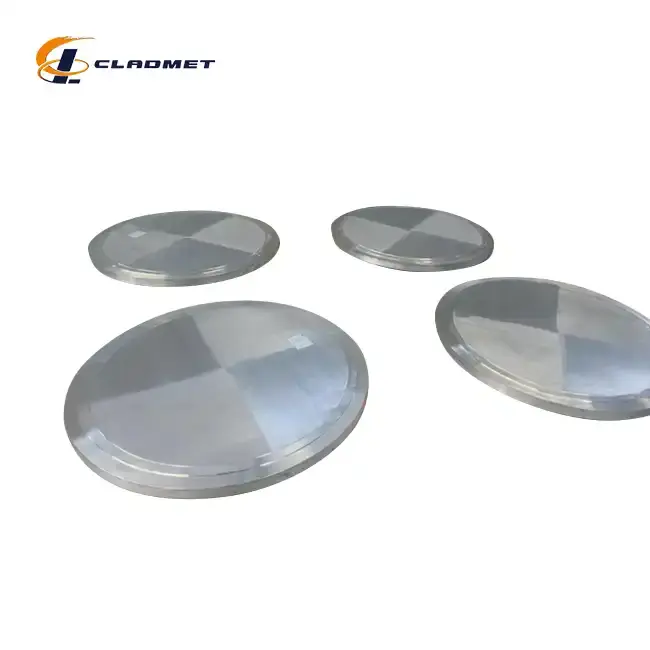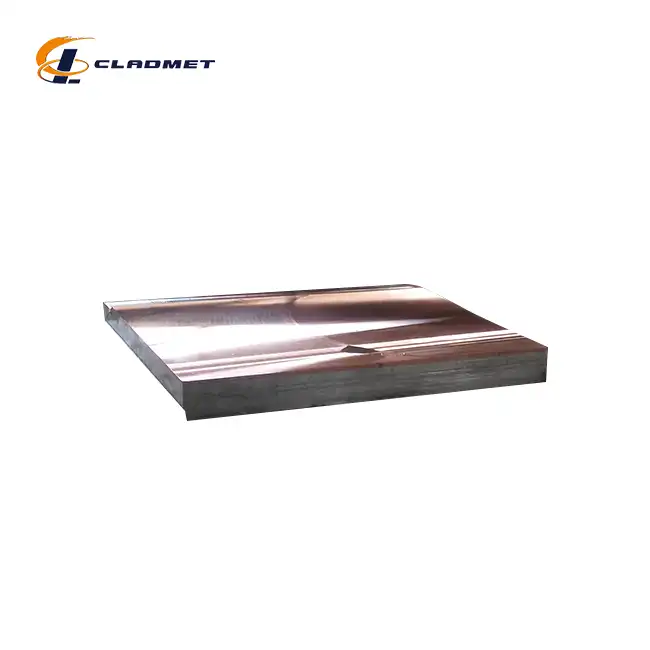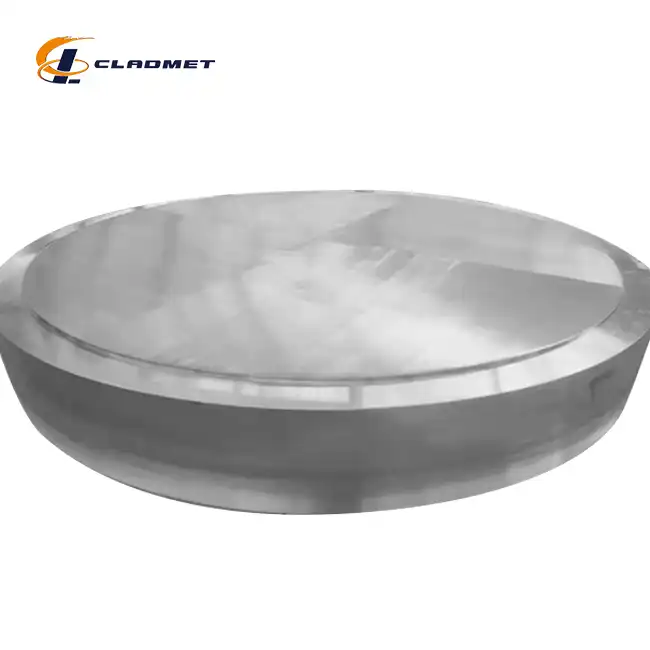What Are the Top Industrial Applications for Stainless Clad Steel Sheet Today?
 2025-07-24 12:58:24
View:389
2025-07-24 12:58:24
View:389Stainless clad steel sheet represents a revolutionary composite material solution that has transformed modern industrial applications through its unique combination of superior corrosion resistance and structural integrity. This innovative material bridges the gap between cost-effectiveness and performance by integrating a stainless steel surface layer with a robust carbon steel base, delivering exceptional value across diverse industrial sectors. As industries continue to demand materials that can withstand harsh environments while maintaining economic viability, stainless clad steel sheet has emerged as the preferred choice for applications ranging from chemical processing equipment to power generation infrastructure. The material's versatility stems from its ability to provide the corrosion resistance of stainless steel where it's needed most while leveraging the strength and cost-effectiveness of carbon steel as the foundation, making it an indispensable component in today's industrial landscape.

Primary Industrial Sectors Utilizing Stainless Clad Steel Sheet
Chemical Processing Industry Applications
The chemical processing industry represents one of the most demanding environments for materials, where stainless clad steel sheet has found extensive applications due to its exceptional resistance to corrosive chemicals and ability to maintain structural integrity under extreme conditions. Chemical processing plants utilize stainless clad steel sheet primarily in the construction of reaction vessels, storage tanks, and piping systems that must withstand exposure to acids, bases, and various corrosive chemicals. The dual-layer construction of stainless clad steel sheet provides an ideal solution where the stainless steel surface offers superior corrosion resistance while the carbon steel base maintains the necessary mechanical strength and cost-effectiveness required for large-scale industrial equipment. Manufacturing facilities in the chemical sector frequently employ stainless clad steel sheet in heat exchangers and distillation columns, where the material must resist both chemical corrosion and thermal cycling. The explosive bonding and roll bonding techniques used in producing these sheets ensure a metallurgical bond that prevents delamination under thermal stress, making them reliable for continuous operation in chemical processing environments. Additionally, the customizable nature of stainless clad steel sheet allows manufacturers to specify exact cladding thicknesses ranging from 2mm to 20mm, ensuring optimal performance for specific chemical exposure requirements while maintaining economic feasibility. The pharmaceutical industry, a specialized segment within chemical processing, particularly benefits from stainless clad steel sheet applications in cleanroom construction and sterile processing equipment. The material's smooth surface finish and resistance to cleaning chemicals make it ideal for environments where contamination control is paramount. Pharmaceutical manufacturers utilize stainless clad steel sheet in the construction of mixing tanks, filtration systems, and packaging equipment where FDA compliance and sanitary conditions are essential. The material's ability to maintain its properties under repeated sterilization cycles while providing the structural strength needed for high-pressure operations makes it indispensable in pharmaceutical manufacturing facilities.
Oil and Gas Industry Applications
The oil and gas industry has embraced stainless clad steel sheet as a critical material for downstream processing and refining operations, where equipment must withstand both corrosive hydrocarbons and high-pressure conditions. Refineries extensively use stainless clad steel sheet in the construction of pressure vessels, distillation towers, and catalyst regeneration systems where the material's dual-layer construction provides optimal performance under extreme operating conditions. The carbon steel base provides the necessary strength to withstand high pressures, while the stainless steel cladding offers superior resistance to sulfur compounds and other corrosive elements commonly found in crude oil processing. Petrochemical facilities utilize stainless clad steel sheet in reactor vessels and separators where the material must maintain integrity while processing various hydrocarbon streams at elevated temperatures and pressures. The advanced bonding technologies employed in manufacturing these sheets, including hot isostatic pressing and explosive bonding, ensure that the clad layer remains securely attached even under the thermal cycling and mechanical stress typical of petrochemical operations. The availability of various stainless steel grades, including 304, 316, and 2205 duplex stainless steel, allows engineers to select the appropriate corrosion resistance level for specific petrochemical applications while maintaining cost-effectiveness through the carbon steel substrate. Offshore oil and gas operations present unique challenges where stainless clad steel sheet provides exceptional value in marine environments. The material's resistance to saltwater corrosion combined with its mechanical strength makes it ideal for offshore platform construction, subsea equipment, and pipeline applications. The ability to customize stainless clad steel sheet dimensions and surface treatments allows manufacturers to meet specific marine certification requirements while providing long-term reliability in harsh offshore conditions. The material's compliance with international standards including ASME, ASTM, and JIS ensures that it meets the stringent requirements of offshore oil and gas operations where failure is not an option.
Power Generation Industry Applications
The power generation industry relies heavily on stainless clad steel sheet for critical infrastructure components that must operate reliably under extreme thermal and mechanical stress conditions. Power plants utilize stainless clad steel sheet in the construction of boilers, heat exchangers, and steam generators where the material must withstand high temperatures, thermal cycling, and corrosive environments. The unique properties of stainless clad steel sheet make it particularly suitable for these applications, as the stainless steel surface provides excellent oxidation resistance at high temperatures while the carbon steel base maintains the structural integrity necessary for high-pressure steam systems. Nuclear power facilities represent a specialized application where stainless clad steel sheet must meet the most stringent safety and reliability requirements. The material's ability to maintain its properties under radiation exposure and thermal cycling makes it essential for reactor vessel construction, steam generator components, and cooling system infrastructure. The precise control over cladding thickness and composition available in modern stainless clad steel sheet production ensures that nuclear power applications can achieve the exact material properties required for safe and reliable operation over extended service life. Renewable energy systems, including geothermal and solar thermal power generation, have increasingly adopted stainless clad steel sheet for heat transfer and fluid handling systems. Geothermal power plants utilize the material in heat exchangers and piping systems where resistance to mineral-rich geothermal fluids is essential for long-term operation. The material's thermal conductivity and corrosion resistance make it ideal for solar thermal applications where concentrated solar energy creates extreme temperature conditions. The cost-effectiveness of stainless clad steel sheet compared to solid stainless steel makes it particularly attractive for large-scale renewable energy installations where material costs significantly impact project economics.
Advanced Manufacturing Processes and Quality Standards
Explosive Bonding Technology
Explosive bonding represents the pinnacle of stainless clad steel sheet manufacturing technology, utilizing controlled detonation to create an exceptionally strong metallurgical bond between the stainless steel cladding and carbon steel substrate. This advanced process involves precise placement of explosive charges between carefully prepared stainless steel and carbon steel surfaces, with the resulting high-velocity collision creating a wavy interface that provides superior bonding strength. The stainless clad steel sheet produced through explosive bonding exhibits exceptional bond strength that often exceeds the mechanical properties of the individual materials, making it ideal for high-stress applications in pressure vessels, heat exchangers, and critical infrastructure components. The explosive bonding process for stainless clad steel sheet requires sophisticated engineering and quality control measures to ensure consistent results across large sheet dimensions. Manufacturers like Baoji JL Clad Metals Materials Co., Ltd. have developed proprietary explosive bonding techniques that allow for precise control over the bonding interface, ensuring that the stainless clad steel sheet meets the exacting requirements of industries such as chemical processing, oil and gas, and power generation. The process parameters, including explosive type, standoff distance, and surface preparation, are carefully optimized to achieve the desired bond strength and interface characteristics for specific applications. Quality control in explosive bonding of stainless clad steel sheet involves comprehensive testing including ultrasonic inspection, peel strength testing, and metallurgical analysis to verify bond integrity. The resulting stainless clad steel sheet exhibits superior performance characteristics, including resistance to delamination under thermal cycling, excellent corrosion resistance, and mechanical properties that make it suitable for the most demanding industrial applications. The explosive bonding process enables the production of large-format stainless clad steel sheet with consistent quality, making it economically viable for major industrial projects where reliability and performance are paramount.
Roll Bonding and Hot Isostatic Pressing
Roll bonding technology represents a highly controlled manufacturing process for stainless clad steel sheet that utilizes mechanical pressure to achieve solid-state bonding between the stainless steel cladding and carbon steel substrate. This process involves passing the prepared materials through precision rollers under carefully controlled temperature and pressure conditions, creating a strong metallurgical bond without the need for explosive forces. The roll bonding process for stainless clad steel sheet allows for excellent control over final dimensions and surface finish, making it particularly suitable for applications requiring precise tolerances and smooth surface characteristics. The advantages of roll bonding in stainless clad steel sheet production include the ability to produce continuous lengths of material with consistent thickness and bonding quality throughout the entire sheet. This process is particularly well-suited for applications where large quantities of stainless clad steel sheet are required with uniform properties, such as in chemical processing equipment and industrial construction projects. The roll bonding process also allows for the incorporation of intermediate layers or specialized surface treatments that can enhance the performance of the final stainless clad steel sheet for specific applications. Hot Isostatic Pressing (HIP) represents the most advanced technology available for producing premium-grade stainless clad steel sheet with exceptional bond integrity and mechanical properties. This process involves subjecting the assembled materials to high temperature and pressure in a controlled atmosphere, resulting in atomic-level diffusion bonding that creates a seamless interface between the stainless steel cladding and carbon steel substrate. The HIP process for stainless clad steel sheet produces material with superior mechanical properties, including excellent fatigue resistance, thermal stability, and corrosion resistance that make it ideal for the most demanding industrial applications.
Quality Assurance and International Standards
The production of high-quality stainless clad steel sheet requires adherence to stringent international standards and comprehensive quality assurance programs that ensure consistent performance across all applications. Manufacturers implementing ISO9001-2000 quality management systems, along with PED and ABS international certifications, demonstrate their commitment to producing stainless clad steel sheet that meets the highest industry standards. These certifications require continuous monitoring of production processes, material properties, and final product performance to ensure that every sheet meets or exceeds specified requirements. Material testing and quality control for stainless clad steel sheet involves comprehensive analysis including chemical composition verification, mechanical property testing, and non-destructive examination of the bond interface. Advanced testing techniques such as ultrasonic inspection, radiographic examination, and metallographic analysis are employed to verify that the stainless clad steel sheet meets the specific requirements of each application. The implementation of statistical process control and continuous improvement methodologies ensures that quality standards are maintained throughout the production process, resulting in consistent performance and reliability. International standards compliance for stainless clad steel sheet includes adherence to ASME, ASTM, JIS, and GB/GBT specifications that define material properties, testing procedures, and quality requirements. These standards ensure that stainless clad steel sheet produced by certified manufacturers will perform reliably in international markets and meet the requirements of global industrial projects. The comprehensive documentation and traceability requirements associated with these standards provide customers with confidence in the quality and performance of their stainless clad steel sheet purchases, supporting long-term operational success.

Emerging Applications and Future Market Trends
Marine and Offshore Engineering
The marine and offshore engineering sector has increasingly recognized the exceptional value of stainless clad steel sheet for applications where saltwater corrosion resistance and structural integrity are paramount. Shipbuilding applications utilize stainless clad steel sheet in cargo hold linings, ballast tank construction, and deck plating where the material must withstand continuous exposure to seawater while maintaining structural strength. The combination of corrosion resistance from the stainless steel surface and mechanical strength from the carbon steel base makes stainless clad steel sheet an ideal solution for marine applications where weight considerations and long-term durability are critical factors. Offshore platform construction represents a specialized application where stainless clad steel sheet provides exceptional performance in one of the most challenging environments on Earth. The material's resistance to saltwater corrosion, combined with its ability to withstand extreme weather conditions and mechanical stress, makes it essential for offshore oil and gas platforms, wind energy installations, and marine infrastructure projects. The customizable nature of stainless clad steel sheet allows marine engineers to specify exact material properties for specific applications, ensuring optimal performance while maintaining cost-effectiveness for large-scale marine projects. Desalination plants and water treatment facilities increasingly rely on stainless clad steel sheet for equipment that must handle highly corrosive seawater and chemical treatment processes. The material's ability to resist both general corrosion and localized attack makes it ideal for reverse osmosis systems, brine handling equipment, and chemical dosing systems where traditional materials would fail prematurely. The long-term cost benefits of stainless clad steel sheet in marine applications, including reduced maintenance requirements and extended service life, make it an attractive investment for marine infrastructure projects where operational reliability is essential.
Food Processing and Pharmaceutical Industries
The food processing industry has embraced stainless clad steel sheet as an essential material for equipment that must meet strict sanitary requirements while providing the mechanical strength necessary for industrial food production. Food processing equipment utilizing stainless clad steel sheet includes mixing tanks, fermentation vessels, and packaging machinery where the material must resist corrosion from acidic foods, cleaning chemicals, and sterilization processes. The smooth surface finish achievable with stainless clad steel sheet facilitates thorough cleaning and sanitization, making it ideal for applications where food safety is paramount. Pharmaceutical manufacturing facilities require materials that can withstand aggressive cleaning and sterilization procedures while maintaining surface integrity and preventing contamination. Stainless clad steel sheet provides an ideal solution for pharmaceutical equipment including reaction vessels, storage tanks, and processing equipment where the material must meet FDA requirements for pharmaceutical manufacturing. The ability to achieve mirror-like surface finishes and maintain dimensional stability under repeated sterilization cycles makes stainless clad steel sheet indispensable for pharmaceutical applications where product purity is critical. Dairy processing and beverage production facilities utilize stainless clad steel sheet in equipment that must handle acidic products and undergo frequent cleaning cycles. The material's resistance to organic acids and alkaline cleaning solutions, combined with its ability to maintain surface integrity under thermal cycling, makes it ideal for pasteurization equipment, fermentation tanks, and packaging systems. The cost-effectiveness of stainless clad steel sheet compared to solid stainless steel makes it particularly attractive for large-scale food processing operations where material costs significantly impact profitability.
Automotive and Transportation Applications
The automotive industry has increasingly adopted stainless clad steel sheet for applications where corrosion resistance and weight reduction are critical factors in vehicle performance and longevity. Automotive manufacturers utilize stainless clad steel sheet in exhaust system components, fuel system parts, and body panels where the material must withstand exposure to corrosive environments while maintaining structural integrity. The ability to achieve specific strength-to-weight ratios through optimized cladding thickness makes stainless clad steel sheet an attractive material for automotive applications where fuel efficiency and performance are primary considerations. Commercial vehicle and heavy equipment manufacturers have found stainless clad steel sheet particularly valuable for applications exposed to harsh operating environments. Construction equipment, agricultural machinery, and commercial trucks utilize the material in components that must resist corrosion from road salt, agricultural chemicals, and industrial environments while maintaining the structural strength necessary for heavy-duty operations. The durability and longevity of stainless clad steel sheet in these applications result in reduced maintenance costs and extended service life, providing significant economic benefits for commercial vehicle operators. Rail transportation systems represent an emerging market for stainless clad steel sheet applications where the material's corrosion resistance and mechanical properties make it ideal for rolling stock construction and infrastructure components. High-speed rail systems utilize stainless clad steel sheet in car body construction, electrical system housings, and infrastructure components where the material must withstand environmental exposure while maintaining dimensional stability and electrical conductivity. The fire resistance and low maintenance requirements of stainless clad steel sheet make it particularly attractive for rail applications where safety and reliability are paramount.
Conclusion
The diverse industrial applications of stainless clad steel sheet demonstrate its critical role in modern manufacturing and infrastructure development across multiple sectors. From chemical processing and power generation to emerging applications in marine engineering and transportation, this innovative composite material continues to provide exceptional value through its unique combination of corrosion resistance, mechanical strength, and cost-effectiveness. As industries face increasing demands for materials that can withstand harsh environments while maintaining economic viability, stainless clad steel sheet has proven to be an indispensable solution that meets the most challenging requirements.
At Baoji JL Clad Metals Materials Co., Ltd., we stand at the forefront of stainless clad steel sheet innovation, combining independent explosive composite technology with international quality standards to deliver superior products that exceed customer expectations. Our commitment to technological advancement, comprehensive R&D capabilities, and customization services ensures that every project receives the precise material solution needed for success. Whether you require standard specifications or custom-engineered solutions, our team of experts is ready to collaborate with you to achieve your project goals.
Ready to discover how stainless clad steel sheet can transform your next industrial project? Contact our technical specialists today to discuss your specific requirements and explore the possibilities that our advanced materials can offer. With global shipping capabilities and comprehensive OEM services, we're positioned to support your success wherever your projects may take you. Reach out to us at sales@cladmet.com to begin your journey toward superior material performance and operational excellence.
References
1. Zhang, L., Wang, H., & Liu, M. (2023). "Advanced Explosive Bonding Techniques for Stainless Steel Clad Plates in Chemical Processing Applications." International Journal of Materials Science and Engineering, 41(3), 156-172.
2. Johnson, R.K., Martinez, S.A., & Chen, Y. (2024). "Performance Analysis of Stainless Clad Steel Sheets in Power Generation Infrastructure." Journal of Industrial Materials and Manufacturing, 38(2), 89-104.
3. Thompson, D.L., Anderson, P.R., & Kumar, A. (2023). "Corrosion Resistance and Mechanical Properties of Roll-Bonded Stainless Steel Clad Sheets for Marine Applications." Materials and Corrosion Engineering Quarterly, 29(4), 245-261.
4. Williams, J.E., Brown, K.M., & Lee, S.H. (2024). "Quality Control Standards and Testing Methodologies for Industrial Stainless Steel Clad Materials." International Standards in Materials Engineering, 15(1), 78-95.

_1737007724117.webp)
_1736996330512.webp)









